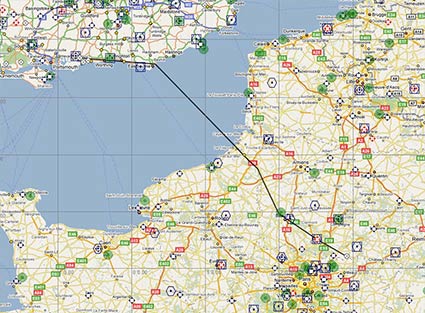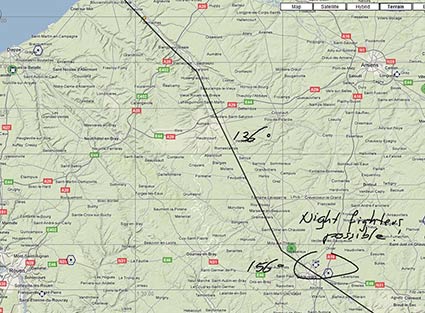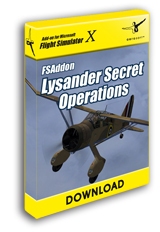Introduction
The Westland Lysander was designated an army co-operation
aircraft replacing Hawker Audaxes and Hectors during 1939. Like other British
army air co-operation
aircraft, it was given the name of a military leader; in this
case, the Spartan general, Lysander. In the forces it was
affectionately known as "Lizzie"
This two-seater, high wing monoplane has many interesting
features. It excels in it's ability to operate from a
small improvised airstrip, its take-off run to clear a
fifty-foot obstacle being only 245 yards. This made possible
clandestine missions behind enemy lines that placed or recovered
agents, particularly in occupied France. The MkIII included in
this package were fitted with a fixed entry/exit ladder on the
port side to hasten access to the rear cockpit and a large drop
tank under the belly.
MkII Lysander's had a 905 hp Bristol Perseus sleeve-valve
air-cooled radial engine. The MkIII had a 870 hp Mercury radial
piston engine. Some MkII's were fitted with twin machine
guns in the rear cockpit, these being designated MkIIA.
A restored, flying Lysander can still be seen in the
world-famous Shuttleworth Collection based at Old Warden
Airfield north of London and it is also a regular participant in the Flying Legends
Airshow at Duxford, last appearing on July 11, 2010. This
model, MA-B is included in this package. A non-flying version
can be seen suspended in the Airspace hangar at Duxford.

9193 Lysander Mk.II of No. 28 Squadron |
 Mk.III with long range tank and step ladder
Mk.III with long range tank and step ladder |
The virtual
Lysander - Special Operations package
As the title suggests, this product is based around the
clandestine flights into and out of France. You get a Secret
Operations Guide which has a full descriptive history of 5
missions, with flight briefings and maps. When I say
missions, this is the old fashioned type not the FSX type
although you do get flight plans and weather files installed.
The 5 included missions are:
- Dec 23, 1942 – Operation Jaguar – flight to Cluny
- Jan 26/27 1943 – Operation Prawn – flight to ‘Courgette’
- July 17/18 1943 – Operation Rénoir – flight to Bouillancy
- July 19/20 1943 – Operation Athlète – flight to ‘Grippe’
- Aug/16/17 1943 – Operation Diplomat – flight to ‘Torticolis’
A Pilots notes manual is included too which you need for whatever type of flying you intend to do, at 40 pages it is quite long and reasonably comprehensive but there were only 11 pages on actual aircraft operation. There are a few pages about the developer and his company and to their credit some interesting pages on the history of the aircraft and the missions. I have mentioned before that I enjoy researching aircraft I review and their history, so the extended history and video links were a great addition for me, you can tell the developer has more than a fondness for the Lizzie!

- P1901 Lysander Mk.II, of Escadrille ‘Rennes’ ,Groupe ‘Bretagne’ of the Free French Air Force, attached to Gen. Leclerc’s forces in North Africa, 1941-1942
- P9193 Lysander Mk.II of No. 28 Squadron, based in Kohat, North West Frontier Province, India in the latter part of 1941
- R1992 Lysander Mk.II of an unidentified unit in North Africa, used to transport Maj.Gen. Ginbachan Singh on troop visits
- V9297 Lysander Mk.III(SD). Special Duty Lysander in the factory fresh paint scheme, as applied at the Ilchester Dispersal Factory
- V9289 Lysander Mk.III(SD) of ’C’ flight (special) of No 357 (SD) Squadron, attached to the 14th Army, South East Asia Command
Download and Installation
The product reviewed here is the Aerosoft download, this product is available elsewhere but in common with a lot of simmers out there, Aerosoft would be my most trusted supplier.
Download is brief given a semi-fast connection. Installation is just a question of following screen prompts and you are under way in a few minutes. The FSX locations are automatically selected but can be overridden if required. The Tangmere scenery is not optional and activates itself in the scenery library. If it conflicts with existing installed scenery then it is easy to remove for the average experienced FSX user.
Internal
When first climbing into the cockpit and looking around you can't help but notice how good the visibility is. Unlike other high-wing aircraft the wing does not obscure the view above the cockpit. The wings are tapered out from the cockpit which gives you the feeling of being further forward than you really are. The stick is very reminiscent of the Spitfire and Hurricane stick being of the same era, the rudder pedals are in almost a V shape so your toes point out rather than a straight ahead position.
On the left hand side of the pit are the expected throttle and mixture controls and the all-important trim wheel. All of these are mouseable as well as keyboard/Joystick controlled. Also, there is a flaps indicator which I couldn't really see was indicating anything so I checked it out later in flight and can confirm it is inoperative. The flaps by the way are automatic as well as the leading edge slats.
 |
in front of the left knee is the rudder trim but it is not a wheel it is a plunger, I wasn't expecting that! Also on this side is the prop pitch, again a plunger, with a bright red knob and a carb cut-out control. Behind the stick is the compass which you cant really read very well unless you lean over the stick, there is a whiskey compass in the lower middle of the main six for everyday use. Just below the main six is the busbar current and voltage indicators.
To the right are the temperature and pressure gauges along with heating, engine priming and starting controls and the cockpit floodlight switch. Confusingly, there is a switch on the right and side window ledge that is marked Flight - Ground, the manual claims this is a tail lock lever but then goes on to say it could be an electrical service switch fir a ground-cart, ground/flight, get it!? The manual also mentions that some of these unsubstantiated controls would be researched further and corrected if necessary. So it could be worth while keeping an eye on FSAddon's web site, I have included links below.
 Cockpit general view
Cockpit general view |

Morse code switch operating the starboard landing light |
So overall, not a complex cockpit, all the controls are clear and the wheels and switches are toggled with a left mouse click only (Except the overhead lamps) or the scroll wheel, I found this quite useable.
External
She sure is a strange looking thing, almost pre-historic. The Lysander is easily recognised by its "dragonfly" wings braced by V-struts, the centre section of the leading edge tapers inboard to give better observation. The trailing edges are fully tapered on the outboard section only. The pilot is perched way up high, great for ground visibility which was essential. The glazed roof of the large cockpit separates the wing roots which were detachable. In each of the wheel spats is a .303 browning machine-gun firing forward clear or the airscrew.
There are two models available, the MKII basic model and the MKIII model which has long range tanks and a step ladder permanently affixed next to the rear cockpit. Both models have the auto slats and flaps so when on the ground these are deployed and can easily be seen.
The included liveries are superb, she really looks like she has been operation from rough fields and has suffered lots of hits by debris, possibly bullets. All the variations above were painted by another Dutch talent, Jan Kees Blom a well known and top-rated re-painter. To have these as standard is a real bonus. You will find yourself searching for more of Jan's repaints after seeing these, here are two examples of a clean version and a beaten up version painted by Jan Kees, these are available from sim-outhouse.com

|

|
This is where you need to start paying attention! Anything shaped like this is bound to be quirky to fly and the Lysander does not disappoint. For me, this is where this product really excels.
Starting the engine was really easy so long as you have the mixture set and pushed the buttons in the correct sequence, there is a start up procedure in the manual from the real thing. I followed this and I also tried an abbreviated made-up version and they both worked so I wonder if the sim is really bothered so long as you have fuel and ignition. I would have like a cold and dark option but it's not that difficult to set up in the sim and save as a flight. Of course there is always the Ctrl+E option if you want to get airborne quick.
The Lysander by default just wants to climb, climb, climb. The engine is quite powerful for the weight and aerodynamic design so using the elevator trim along with precise throttle control is essential in normal flight. The take off roll is about, what? 50 feet?! look at the shot below, normal procedure taking off from the numbers, I am already 1ft off the ground!
 1ft off the ground, having started on the numbers! |
Once you pass about 80mph you will hear and see the slats and flaps retracting, from hereon-in she is fairly predictable to fly excepting the tendency to keep climbing. In normal flight I was impressed on how fast she is, maintaining 200mph in the cruise was no problem. Of course, if you were flying a covert mission deep into France you would lean her off more and cut the revs for greater range.
Apparently, the allowed diving speed is 300mph I didn't try that but I did perform a rather good Immelmann loop and roll-out! I'm not sure this is allowed but the powerful engine will cope with it fine, just don't spend too much time inverted!
 |
So now I am happy with being in the air, I want to get back onto terra-firma. The main trauma is getting her to slow down, on my first attempt at landing I bounced down the runway like I was on a space hopper, this was purely in the name of research of course! My first decent landing was made with a very long approach, almost gliding in with a very slight nose up attitude, at 80, the slats and flaps deploy and will sent you skyward if you are not prepared! On final, the best way to control the GS is with the throttle, by now you have to have her trimmed as any big control surface inputs could have serious consequences.
I found the best touch down speed to be just over 60mph, she will almost drop out of the sky at 50 so throttling back at the correct time is essential and you should be able to land her on all three and keep the stick back whilst gentle breaking otherwise you could tip over. Turning on the ground has to be done at low speeds too to otherwise the wing will drop and you will crash!
The overall flying characteristics, for me, were as expected from what I have read about the real Lizzie. I feel spurred on to try more difficult approaches, cue the special operations!
Special Operations
Did I mention navigation? You're right, I didn't! Map, compass, eyeball. Totally VFR by day and really the same by night helped along by the artificial horizon and attitude indicators. Considering night ops were made when there was a new moon you have to admire these pilot's homing instincts.
There are 5 special operations included, They all have their own pdf flight plans and maps. The flight plan includes headings, distances and times flying that heading at 155mph / 1900ft (ETE) The maps, depending on which operation were varied.

|

|
As these are not missions in the true sense of the word you will not know if you are successful, it's like flying any FS flight, it is up to you to judge if you were successful and did not cheat!
One of the flights, "Operation Athlete" comes with a Google Earth kmz file so you can see the waypoints on a photoreal background. This did not serve any purpose for me but was a kind thought.
More missions are promised but as yet hey have not materialised on the FSAddon's site although the downloads page simply say the page was taken off-line due to a hack attack, I hope they recover from this soon.
Sim performance
All I can say is this is easy on frames and easy on the eye. I didn't have to step back any of my scenery setting to accommodate this aircraft, an overall high set up should be ok for most users.
Extra Scenery
One of the FSAddon's team, Japp van Hees, has contributed a 1940's period version of RAF Tangmere. On first view it looks very nice with a couple of blister hangars, anti-aircraft balloon, DC3's etc but there are two clusters of Hurricanes on the the ground that keep flickering on and off. Scenery and traffic adjustments made no difference. This is annoying and should be fixed in my view. If you disregard the Hurricanes then the scenery is a welcome edition. It can also be disabled in the scenery library if needed.

![]() Verdict
Verdict
I really enjoyed flying the Lizzie, it is such
an unusual flying experience that you will want to keep
trying to perfect that short-field landing. The flight model
seemed suitably realistic and quirky, that is a compliment
by the way!
The external
quality is excellent, it is a shame the cockpit was a bit
dark and dull on the panel but it may well be like that in
the real world.
I liked the old fashioned "missions" and I hope FSAddon
keep to their promise of publishing more.
All in all, a neat little package, I feel as though it is a
little overpriced at
€29.69. The Gladiator, also a FSAddon product I have, being priced at
€16.00 is bang on the money (If not a bit too cheap), this one deserves to be more
like €20 in my book.
I am going to award this a Mutley's Hangar score of
8.5 /10.
![]()
Joe Lawford
Review machine Spec: Core i7 Extreme 965 @ 3.6 Ghz |
12Gb Tri-Channel Corsair DDR3 Ram |GX260 Graphics |Windows 7
64bit Pro
nVidia 64bit driver 258.96 WHQL | - nHancer 2.5.9
 |
System Requirements
|
|
Bonus Review Content
I was contacted about this review by Bob Lomas who has a vivid recollection of this aircraft and he wrote the following... "You are to be congratulated both for your website and your extensive review of Francois' Lysander and SOE game. Please allow me to introduce myself. I am very old having grown up during WW II under the Battle of Britain, not far from Tangmere and along side one of its satellite airfields, Parham, now the home of the Southdown Gliding Club. I saw Lyzzies several times a week. Our farm barn was requisitioned for warplane final fitting, the aeroplanes had to be dispersed from the factories. This allowed me to fly the aeroplanes for all hours providing I never flew out through the barn doors. One such aeroplane was the Lyzzie which quickly became my firm favourite and my walls have carried pictures of them to this day." Bob also sent in a semi-biographical story relating to the above, please click here to read on. |
|
|
|
|
